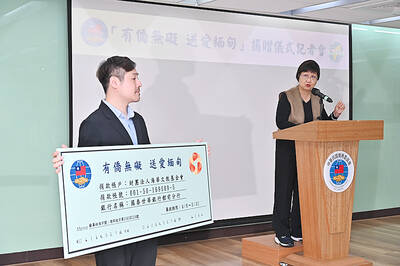An environmental protection group yesterday said that Kinmen County could become overly dependent on China after the county signed a landmark water agreement with Chinese authorities on Monday.
Purchasing water from China means that Beijing would have increased control over the region, Taiwan Water Resources Protection Union director Jennifer Nien (粘麗玉) said, adding that Beijing could use the deal to coerce Kinmen into submitting to its demands by severing water supplies or increasing prices.
She urged the Kinmen County Government to build seawater desalination plants, preserve its groundwater reserves and carry out regular reservoir dredging work so that the county can retain a degree of water sovereignty in the event of a worst-case scenario.
Under Monday’s agreement, China is to deliver 15,000 tonnes of water per day to Kinmen, with the amount gradually increasing over time to 34,000 tonnes per day starting from the 10th year of the arrangement.
The pact also poses a risk to Kinmen’s environment and quality of life, Nien said, citing concerns over the construction of an underwater pipeline connecting China’s Fujian Province and Kinmen, which is scheduled to be completed by the end of 2017.
The quality of the water from China is also questionable, as water in Chinese reservoirs often contains high concentrations of impurities, she said.
“People in many Chinese provinces do not bother to boil tap water. Instead they use water dispensers and buy drinking water from private firms,” she said.
Citing Chinese Nationalist Party (KMT) Legislator Yang Ying-hsiung’s (楊應雄) pledge to push for Kinmen to be allowed to purchase electricity from China as well, Nien said that if utilities on Kinmen come under Beijing’s control, it would bring Kinmen closer to China and compromise its status as Taiwan’s military outpost.

Taiwan is stepping up plans to create self-sufficient supply chains for combat drones and increase foreign orders from the US to counter China’s numerical superiority, a defense official said on Saturday. Commenting on condition of anonymity, the official said the nation’s armed forces are in agreement with US Admiral Samuel Paparo’s assessment that Taiwan’s military must be prepared to turn the nation’s waters into a “hellscape” for the Chinese People’s Liberation Army (PLA). Paparo, the commander of the US Indo-Pacific Command, reiterated the concept during a Congressional hearing in Washington on Wednesday. He first coined the term in a security conference last

DEFENSE: The National Security Bureau promised to expand communication and intelligence cooperation with global partners and enhance its strategic analytical skills China has not only increased military exercises and “gray zone” tactics against Taiwan this year, but also continues to recruit military personnel for espionage, the National Security Bureau (NSB) said yesterday in a report to the Legislative Yuan. The bureau submitted the report ahead of NSB Director-General Tsai Ming-yen’s (蔡明彥) appearance before the Foreign and National Defense Committee today. Last year, the Chinese People’s Liberation Army (PLA) conducted “Joint Sword-2024A and B” military exercises targeting Taiwan and carried out 40 combat readiness patrols, the bureau said. In addition, Chinese military aircraft entered Taiwan’s airspace 3,070 times last year, up about

A magnitude 4.3 earthquake struck eastern Taiwan's Hualien County at 8:31am today, according to the Central Weather Administration (CWA). The epicenter of the temblor was located in Hualien County, about 70.3 kilometers south southwest of Hualien County Hall, at a depth of 23.2km, according to the administration. There were no immediate reports of damage resulting from the quake. The earthquake's intensity, which gauges the actual effect of a temblor, was highest in Taitung County, where it measured 3 on Taiwan's 7-tier intensity scale. The quake also measured an intensity of 2 in Hualien and Nantou counties, the CWA said.

The Overseas Community Affairs Council (OCAC) yesterday announced a fundraising campaign to support survivors of the magnitude 7.7 earthquake that struck Myanmar on March 28, with two prayer events scheduled in Taipei and Taichung later this week. “While initial rescue operations have concluded [in Myanmar], many survivors are now facing increasingly difficult living conditions,” OCAC Minister Hsu Chia-ching (徐佳青) told a news conference in Taipei. The fundraising campaign, which runs through May 31, is focused on supporting the reconstruction of damaged overseas compatriot schools, assisting students from Myanmar in Taiwan, and providing essential items, such as drinking water, food and medical supplies,